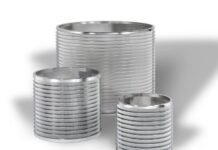Vadodara-based Jash Packaging installed the first brand new Manroland 708LV+UV Evolution offset press in India about two years ago. The 8-color full UV press with coater represented one of the first high configuration sales of a new Manroland sheetfed multi-color packaging press by its distribution, sales, and service company in India. Manroland Sheetfed India was established following the German sheetfed offset press manufacturer’s acquisition by the UK-headquartered Langley Holdings. The Evolution series press at Jash is a state-of-the-art sheetfed offset with high automation and decoration options that seek to re-establish the recognized dominance of the Roland 700 series in board packaging.
In use for over two years, the Evolution 8-color with coater at Jash has proven to be a workhorse producing quality packaging for several packaging segments in India and exports. Even during the Covid-19 pandemic and lockdown, the Evolution 708LV+UV has continuously produced cartons for the food, dairy, liquor, personal care, and tobacco sectors, including many designs with metallics.
While the rated speed of the press is 18,000 sheets an hour for both conventional and UV cured cartons, at Yash, it has produced every type of printing at speeds of 15,000 to 16,000 sheets an hour. The Evolution has a new feeder head, a highly responsive ink train, and a dampening system that substantially reduces make-ready and running wastage.
In its approximately two years of use so far, Jash’s Manroland 8-color has printed 40 million (4 crore) sheets without any trouble. In a bid to maintain its 20% growth year on year, and in the face of good market demand, the company has invested in more converting equipment from Bobst for the carton converting unit.
Jash Packaging ups throughput with two Bobst folder-gluers
A few months ago, Jash Packaging purchased two Bobst folder-gluers – a Visionfold 110 A2 and an Ambition 76 A1, to balance and streamline its carton converting production. The two new folder-gluers are installed at its carton unit in the city, along with the two existing Bobst machines there – a Lila II 145 A2 folder-gluer and a Novacut 106 E die-cutter.
The company currently converts approximately 4,000 tons of corrugated and about 1,000 tons of solid board each month. According to Jash’s proprietor Ravindra Patel, there was a demand-supply gap or a constraint in the folder gluer section. The company faced difficulties in delivering the volumes required by customers on time. “We decided to ramp up the finishing capabilities and bolstered the two existing folder-gluers with the addition of two new Bobst machines,” said Patel, who is assisted by his son Kishan in running the business.
The Bobst Ambition 76 A1 features a straight line open-width of 76 to 760 mm, and a lock bottom open-width of 146 to 760mm and running speeds up to 300 meters a minute. The new Bobst Visionfold 110 A2 has a straight line open-width of 76 to 1,100 mm and a lock-bottom open-width of 146 to 1,100 mm at speeds up to 350 meters a minute.
“Both machines are capable of running straight line, crash lock bottom, disproportionate outer cartons, and litho-laminated 3-ply cartons. The Visionfold 110 A2 is also equipped to run specialty 4- and 6-corner cartons. Consistency and faster job changeovers allow the customer to achieve more production in the given time,” said Bobst India’s Western region sales manager.
Handypack automation
Yash has also installed Bobst’s Handypack kit on the delivery section of both the new folder-gluers. The automation option, according to Patel, increases the productivity of the folder-gluer through easy carton collection. The automation option optimizes the utilization of the folder-gluers and minimizes the manual handling required at the delivery end.
Ravindra Patel says, “Increasing the total capacity to offer prompt service to our customers was our main requirement. We looked at the machines manufactured in the Far East, and found they were slower compared to the ones from Bobst.”
He adds, “We have had a good history of growth. Times are tough, but one has to be aggressive and proactive and vigilant and shrewd, to continue the streak of success. In our endeavor, we relied on Bobst because of its prompt service, the process support to hand-hold us, and to get the machine to reach its optimum level of performance. The investment has boosted our production level substantially compared to what we were able to achieve earlier.”
















